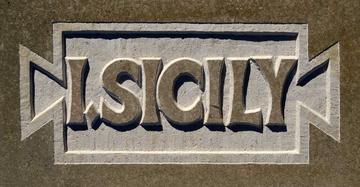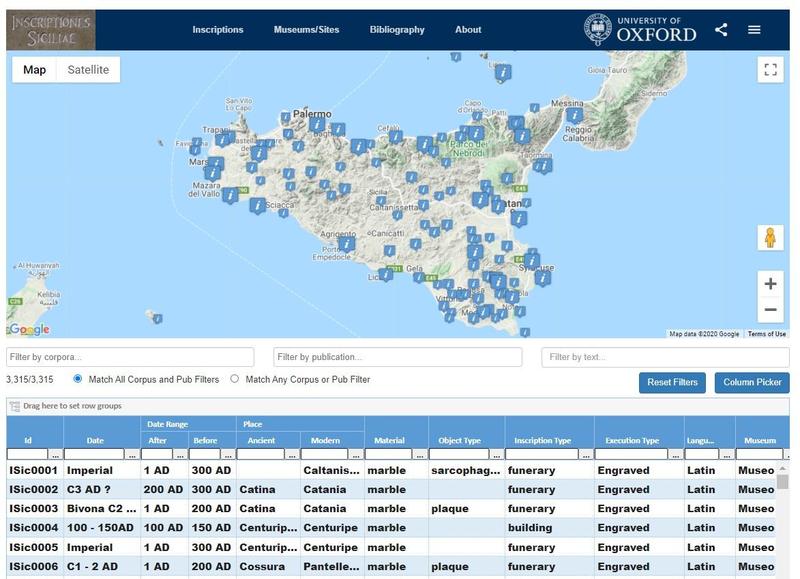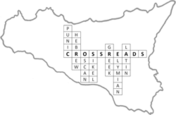The I-Sicily project

I.Sicily is a long-term project to construct and maintain a digital corpus of the inscriptions of ancient Sicily. The project aims to provide free open access data, and to follow the principles of Linked Open Data wherever possible.The online corpus, live since 2017, can be found at: http://sicily.classics.ox.ac.uk
The I.Sicily project aims to include all types of inscribed text, in all languages, across the whole of antiquity, beginning with the first written texts at the end of the seventh century BCE, and continuing through to the Byzantine period (currently with an approximate upper limit of the seventh century CE). The project began with a focus on texts on stone, and with an initial emphasis on the metadata (bibliography and information about the inscription, such as material, language and inscription type). Coverage has steadily expanded to include over 3,300 inscriptions, primarily on stone, some fully edited, most in draft. Within the framework of the Crossreads project we expect to add the remaining c.1,000 texts on stone (primarily material from the Syracuse catacombs), and to incorporate texts on metal, ceramic and other instrumentum domesticum (portable objects). We additionally plan to incorporate texts that were stamped onto brick and tile, and coin legends.
I.Sicily employs the EpiDoc TEI-XML standard. We use this to encode all the information about the inscription and the inscribed object, as well as the actual text itself: we create a full edition of the inscription, but directly encoded in EpiDoc, which enables processing of all the information. These individual editions are published as HTML pages but can also be searched and filtered through the website, as well as being freely available for download. We also present high resolution images where available, and publish bibliography (in Zotero) and collection information through a database of Sicilian museums. Data is standardised and made potentially interopable by means of the use of recognised vocabularies, such as the Pleiades gazetteer of ancient places and the EAGLE epigraphic vocabularies.

Two aspects of I.Sicily are perhaps worth highlighting:
- All inscriptions are allocated a unique six-digit number (format ISic001234). A primary ambition of the project is the disambiguation and secure identification of all texts. I.Sicily records (will) contain a full bibliography of past editions, such that the I.Sicily record can serve as a single point of reference. Additionally, I.Sicily numbers are aligned with (and the files make visible) the Trismegistos number for each inscription (Trismegistos is a project to provide a unique identifier for all ancient texts, epigraphic and papyrological). Any I.Sicily number can be resolved by a URL of the form: http://sicily.classics.ox.ac.uk/inscription/ISic001234
- I.Sicily editions are true editions, but also are subject to ongoing editing and revision. We encourage users to cite them as such, referencing the contributors (please give our many collaborators their due credit) and the date of most recent edit. In order to cite a stable copy of the current online edition (in both XML and human-readable PDF), please note the citation advice at the foot of each file. If the file has been edited to at least draft level, this will include reference to a stable copy deposited in the Zenodo repository with a DOI (see e.g. http://doi.org/10.5281/zenodo.4021517), which will persist even if the file is further edited in the future.
Finally, I.Sicily is a highly collaborative project, working both with archaeologists and curators in Sicily and with multiple scholars and students internationally. Files are primarily edited in the project’s GitHub repository (link: https://github.com/ISicily/ISicily) and we welcome expressions of interest to join in the project.
For more information about I.Sicily, please visit the supporting website at http://isicily.org
You can read more about I.Sicily in the following publications:
Prag, J.R.W. (2019), 'I.Sicily, Open Scholarship, and the Epigraphic Landscape of Hellenistic/Roman Sicily', Ktema: Civilisations de l’Orient, de la Grece et de Rome antiques 44: 107–22. Online at: https://halshs.archives-ouvertes.fr/halshs-02444349
Prag, J.RW. and Chartrand, J. (2018), 'I. Sicily: Building a Digital Corpus of the Inscriptions of Ancient Sicily' in A. De Santis and I. Rossi (eds.), Crossing Experiences in Digital Epigraphy (Warsaw: De Gruyter Open), 240-252. DOI: https://doi.org/10.1515/9783110607208-020.
Agodi, S., Cristofaro, S., Noto, V., Prag, J. and Spampinato, D. (2018), 'Una collaborazione tra museo, enti di ricerca e scuola: l’epigrafia digitale e l’alternanza scuola lavoro', Umanistica Digitale 2 (May 2018). ISSN 2532-8816. DOI: https://doi.org/10.6092/issn.2532-8816/7298.
Prag, J.R.W., Chartrand, J., and Cummings, J. (2017), 'I.Sicily: an epidoc corpus for ancient Sicily', in S. Orlandi, R. Santucci, P.M Liuzzo and F. Mambrini (eds), Digital and Traditional Epigraphy in Context. Proceedings of the Second EAGLE International Conference. Rome 27-29 January 2016. Rome: Sapienza Università Editrice : 83-96. DOI: https://doi.org/10.13133/978-88-9377-021-7.



